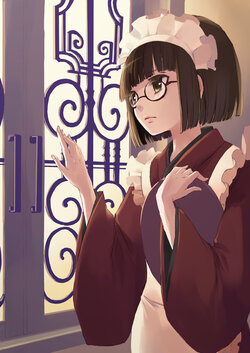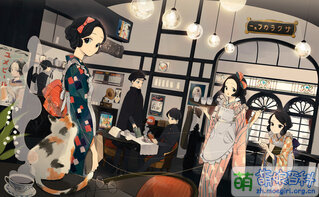Difference between revisions of "Taishō maid"
(Finished translating paragraph) |
(Finished translating section, added category) |
||
| Line 16: | Line 16: | ||
The image of a ''kyūji-onna'' appears in ACG works set in the Taishō era, usually reflecting the typical style of "East meets West" and "eclecticism with the West" of that era: a plain white frilly apron with small ''[[furisode]]'' and an ''[[andon bakama]]'', or the image of dark groundless ''furisode''. | The image of a ''kyūji-onna'' appears in ACG works set in the Taishō era, usually reflecting the typical style of "East meets West" and "eclecticism with the West" of that era: a plain white frilly apron with small ''[[furisode]]'' and an ''[[andon bakama]]'', or the image of dark groundless ''furisode''. | ||
| − | Usually there was no fixed salary for the ''kyūji-onna'', and the income came mainly from tips of the customers. The amount of pay depended on the level of service provided to the women themselves, however, the simple act of serving tea or water almost limited them to smile to win the goodwill of customers. With the changing times and the increasing competition in the same industry, the service of "selling smiles" has developed into one-on-one conversation, dancing, physical contact and escorting. The "Taishō romance" between the famous writers and the ''kyūji-onna'' of that era is unique. And after cafes, which were places for ''kyūji-onna'', it irreversibly spread from the upper class to the common people, and the ''kyūji-onna'' industry had been completely transformed into a sex industry, seizing the blank space left over from the abolition of public prostitution, making it be incorporated into the pornography control of the Police Department back in 1933.<ref name="guokr" /> From its rise to its fall in the early Showa period, the ''kyūji-onna'' with an impression of pure love spanned a period of the Taishō era which was neither too long, nor too short. | + | Usually there was no fixed salary for the ''kyūji-onna'', and the income came mainly from tips of the customers. The amount of pay depended on the level of service provided to the women themselves, however, the simple act of serving tea or water almost limited them to smile to win the goodwill of customers. With the changing times and the increasing competition in the same industry, the service of "selling smiles" has developed into one-on-one conversation, dancing, physical contact and escorting. The "Taishō romance" ({{lj|大正浪漫}}, ''taishō roman'') between the famous writers and the ''kyūji-onna'' of that era is unique. And after cafes, which were places for ''kyūji-onna'', it irreversibly spread from the upper class to the common people, and the ''kyūji-onna'' industry had been completely transformed into a sex industry, seizing the blank space left over from the abolition of public prostitution, making it be incorporated into the pornography control of the Police Department back in 1933.<ref name="guokr" /> From its rise to its fall in the early Showa period, the ''kyūji-onna'' with an impression of pure love spanned a period of the Taishō era which was neither too long, nor too short. |
[[File:Cafe no Asa.jpg|left|thumb|320px|A group of Taishō maids in a "Japanese-Western mix" style<ref>[https://www.pixiv.net/artworks/42948844 ''Cafe no Asa'' ({{lj|カフェーの朝}})] Author: Toinana ({{lj|問七}}) [Pixiv ID: [https://www.pixiv.net/member.php?id=1826470 1826470]]</ref>]] | [[File:Cafe no Asa.jpg|left|thumb|320px|A group of Taishō maids in a "Japanese-Western mix" style<ref>[https://www.pixiv.net/artworks/42948844 ''Cafe no Asa'' ({{lj|カフェーの朝}})] Author: Toinana ({{lj|問七}}) [Pixiv ID: [https://www.pixiv.net/member.php?id=1826470 1826470]]</ref>]] | ||
| + | |||
| + | === Taishō maids in the present day === | ||
| + | The rise of ACG maid culture has not prevented the people from bringing the imaginarium of ''Taishō roman'' into it. A genre of "Taishō maids" with a strong Taishō-era schoolgirl atmosphere was created. The "Taishō maid" image does not strictly require that the maid wear foreign outfits, however, the Taishō elements of the kimono worn and the schoolgirl's youthfulness will be emphasized: that is, it is still stylized with two long ''furisode'' and a hakama. In particular, the ''kasuri furisode'' sleeves and the Purple Guard attire, at this time, are the actual preference for the combination of Taishō schoolgirl and maid. If there is an [[apron]] in addition to the kimono, then the shape is much closer to the prototype given to ''kyūji-onna''. | ||
| + | |||
| + | Taishō maids are a type of [[wafuu maid]] that blend Japanese and Western elements, therefore, although there are [[maid cafe|maid cafes]] in Japan whose main selling point is the romantic atmosphere of the Taishō period, the term "Taisho maid" is not that common, the terms ''taishō roman'', ''wafuu maid'' and ''jyokyū'' are used instead. | ||
| + | |||
| + | [[File:Taishō Maid 01.jpg|left|thumb|300px|A group of maids in ''kasuri furisode'' in the Akihabara ''taishō roman''-themed cafe "Enromankan"]] | ||
| + | |||
{{Moe points|Identity, Professions and Species}} | {{Moe points|Identity, Professions and Species}} | ||
| + | |||
| + | [[Category:Professions]] | ||
== References == | == References == | ||
<references /> | <references /> | ||
[[Category:Professions]] | [[Category:Professions]] | ||
Latest revision as of 20:51, 25 May 2023
Moegirlpedia would welcome your assistance in improving this article☆Kira~
As you read this article, you're welcome to participate in editing this page. Before editing, please read the wiki quickstart, editing guidelines and retrieve relevant information. We wish you a good time on Moegirlpedia. |
 Machibito Kozu (待ち人来ず). Author: Gin (吟)[1] | |
| Base Info | |
| Moe Point | Jyokyū ( Kyūji-onna ( |
|---|---|
| Moe Point Synonyms | Taishō maid ( |
| Related Moe Points | Maid |
A taishō maid is a type of maid, the imaginary combination of maid culture and Taishō romance, and one of the moe points in ACG subculture.
Introduction
Origin
Strictly speaking, in the Taishō era when there was no ACG maid culture today, the "Taisho maids" were only the aesthetic imagination of today's people. However, back in the late Meiji and early Taishō period, when cafes first became popular, the women who were active in it (the kyūji-onna) were a real presence in the new pop culture. Enlightenment and romanticism brewed a social trend of pursuing individual liberation, and the cafés, as a foreign thing, initially attracted groups of cultural people with petty upper-class sentiments to meet and hold events in it. Some Osaka-centered cafes were the first to offer jobs to the then newly liberated women. These old "maid cafes" were also called Osaka-style cafes in those days.[2]
The image of a kyūji-onna appears in ACG works set in the Taishō era, usually reflecting the typical style of "East meets West" and "eclecticism with the West" of that era: a plain white frilly apron with small furisode and an andon bakama, or the image of dark groundless furisode.
Usually there was no fixed salary for the kyūji-onna, and the income came mainly from tips of the customers. The amount of pay depended on the level of service provided to the women themselves, however, the simple act of serving tea or water almost limited them to smile to win the goodwill of customers. With the changing times and the increasing competition in the same industry, the service of "selling smiles" has developed into one-on-one conversation, dancing, physical contact and escorting. The "Taishō romance" (大正浪漫, taishō roman) between the famous writers and the kyūji-onna of that era is unique. And after cafes, which were places for kyūji-onna, it irreversibly spread from the upper class to the common people, and the kyūji-onna industry had been completely transformed into a sex industry, seizing the blank space left over from the abolition of public prostitution, making it be incorporated into the pornography control of the Police Department back in 1933.[2] From its rise to its fall in the early Showa period, the kyūji-onna with an impression of pure love spanned a period of the Taishō era which was neither too long, nor too short.

Taishō maids in the present day
The rise of ACG maid culture has not prevented the people from bringing the imaginarium of Taishō roman into it. A genre of "Taishō maids" with a strong Taishō-era schoolgirl atmosphere was created. The "Taishō maid" image does not strictly require that the maid wear foreign outfits, however, the Taishō elements of the kimono worn and the schoolgirl's youthfulness will be emphasized: that is, it is still stylized with two long furisode and a hakama. In particular, the kasuri furisode sleeves and the Purple Guard attire, at this time, are the actual preference for the combination of Taishō schoolgirl and maid. If there is an apron in addition to the kimono, then the shape is much closer to the prototype given to kyūji-onna.
Taishō maids are a type of wafuu maid that blend Japanese and Western elements, therefore, although there are maid cafes in Japan whose main selling point is the romantic atmosphere of the Taishō period, the term "Taisho maid" is not that common, the terms taishō roman, wafuu maid and jyokyū are used instead.
References
- ↑ Gin [Pixiv ID: 113939]: 待ち人来ず
- ↑ 2.0 2.1 壹读:《关于日本:一百年前的女仆咖啡厅》
- ↑ Cafe no Asa (カフェーの朝) Author: Toinana (問七) [Pixiv ID: 1826470]